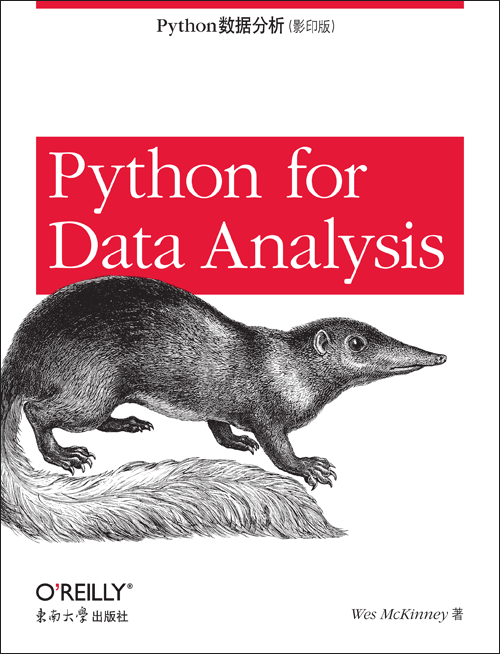Python数据分析(影印版)
出版时间:2013年06月
页数:472
“科学和数据分析领域已经等了这本书好几年了:具有具体的实用建议以及如何聚沙成塔的见解。它应该会成为接下来若干年里Python科学计算方面的经典参考资料。”
——Fernando Perez
UC Berkeley大学的助理研究员,也是IPython的原创作者之一
你是否在寻找一本完整介绍Python操纵、处理、提取和压缩结构化数据的指南?本书包含了许多实例分析,通过若干个Python库——包括NumPy,pandas,matplotlib和IPython——为你展示了如何高效地解决大量数据分析的问题。
《Python数据分析》由Wes McKinney撰写,他是pandas库的主要作者。本书也是一本具有实践性的指南,指导那些使用Python进行科学计算的数据密集型应用。它适用于刚刚开始使用Python的分析师,或者是进入科学计算领域的Python程序员。
· 使用IPython交互式shell作为你的主要开发环境
· 学习NumPy(Numerical Python)的基础和高级特性
· 接触pandas库中的数据分析工具
· 使用高性能工具来加载、抽取、转换、合并和改造数据
· 使用matplotlib来创建散点图和静态或者交互式可视化数据
· 运用pandas的groupby功能来对数据集进行切片、切块和汇总
· 通过具体实例来学习如何解决web分析、社交科学、金融和经济领域的问题
Wes McKinney是pandas的主要作者,pandas是Python中流行的数据分析开源库。他一开始是AQR资产管理公司的量化分析师,后来创办了Lambda Foundry——一家企业数据分析公司。Wes是Python和开源社区的活跃讲师和参与者。
——Fernando Perez
UC Berkeley大学的助理研究员,也是IPython的原创作者之一
你是否在寻找一本完整介绍Python操纵、处理、提取和压缩结构化数据的指南?本书包含了许多实例分析,通过若干个Python库——包括NumPy,pandas,matplotlib和IPython——为你展示了如何高效地解决大量数据分析的问题。
《Python数据分析》由Wes McKinney撰写,他是pandas库的主要作者。本书也是一本具有实践性的指南,指导那些使用Python进行科学计算的数据密集型应用。它适用于刚刚开始使用Python的分析师,或者是进入科学计算领域的Python程序员。
· 使用IPython交互式shell作为你的主要开发环境
· 学习NumPy(Numerical Python)的基础和高级特性
· 接触pandas库中的数据分析工具
· 使用高性能工具来加载、抽取、转换、合并和改造数据
· 使用matplotlib来创建散点图和静态或者交互式可视化数据
· 运用pandas的groupby功能来对数据集进行切片、切块和汇总
· 通过具体实例来学习如何解决web分析、社交科学、金融和经济领域的问题
Wes McKinney是pandas的主要作者,pandas是Python中流行的数据分析开源库。他一开始是AQR资产管理公司的量化分析师,后来创办了Lambda Foundry——一家企业数据分析公司。Wes是Python和开源社区的活跃讲师和参与者。
- Chapter 1: Preliminaries
- What Is This Book About?
- Why Python for Data Analysis?
- Essential Python Libraries
- Installation and Setup
- Community and Conferences
- Navigating This Book
- Acknowledgements
- Chapter 2: Introductory Examples
- 1.usa.gov data from bit.ly
- MovieLens 1M Data Set
- US Baby Names 1880-2010
- Conclusions and The Path Ahead
- Chapter 3: IPython: An Interactive Computing and Development Environment
- IPython Basics
- Using the Command History
- Interacting with the Operating System
- Software Development Tools
- IPython HTML Notebook
- Tips for Productive Code Development Using IPython
- Advanced IPython Features
- Credits
- Chapter 4: NumPy Basics: Arrays and Vectorized Computation
- The NumPy ndarray: A Multidimensional Array Object
- Universal Functions: Fast Element-wise Array Functions
- Data Processing Using Arrays
- File Input and Output with Arrays
- Linear Algebra
- Random Number Generation
- Example: Random Walks
- Chapter 5: Getting Started with pandas
- Introduction to pandas Data Structures
- Essential Functionality
- Summarizing and Computing Descriptive Statistics
- Handling Missing Data
- Hierarchical Indexing
- Other pandas Topics
- Chapter 6: Data Loading, Storage, and File Formats
- Reading and Writing Data in Text Format
- Binary Data Formats
- Interacting with HTML and Web APIs
- Interacting with Databases
- Chapter 7: Data Wrangling: Clean, Transform, Merge, Reshape
- Combining and Merging Data Sets
- Reshaping and Pivoting
- Data Transformation
- String Manipulation
- Example: USDA Food Database
- Chapter 8: Plotting and Visualization
- A Brief matplotlib API Primer
- Plotting Functions in pandas
- Plotting Maps: Visualizing Haiti Earthquake Crisis Data
- Python Visualization Tool Ecosystem
- Chapter 9: Data Aggregation and Group Operations
- GroupBy Mechanics
- Data Aggregation
- Group-wise Operations and Transformations
- Pivot Tables and Cross-Tabulation
- Example: 2012 Federal Election Commission Database
- Chapter 10: Time Series
- Date and Time Data Types and Tools
- Time Series Basics
- Date Ranges, Frequencies, and Shifting
- Time Zone Handling
- Periods and Period Arithmetic
- Resampling and Frequency Conversion
- Time Series Plotting
- Moving Window Functions
- Performance and Memory Usage Notes
- Chapter 11: Financial and Economic Data Applications
- Data Munging Topics
- Group Transforms and Analysis
- More Example Applications
- Chapter 12: Advanced NumPy
- ndarray Object Internals
- Advanced Array Manipulation
- Broadcasting
- Advanced ufunc Usage
- Structured and Record Arrays
- More About Sorting
- NumPy Matrix Class
- Advanced Array Input and Output
- Performance Tips
- Appendix: Python Language Essentials
- The Python Interpreter
- The Basics
- Data Structures and Sequences
- Functions
- Files and the operating system
书名:Python数据分析(影印版)
作者:Wes McKinney 著
国内出版社:东南大学出版社
出版时间:2013年06月
页数:472
书号:978-7-5641-4204-9
原版书书名:Python for Data Analysis
原版书出版商:O'Reilly Media
The animal on the cover of Python for Data Analysis is a golden-tailed, or pen-tailed, tree shrew (Ptilocercus lowii). The golden-tailed tree shrew is the only one of its species in the genus Ptilocercus and family Ptilocercidae; all the other tree shrews are of the family Tupaiidae. Tree shrews are identified by their long tails and soft red-brown fur. As nicknamed, the golden-tailed tree shrew has a tail that resembles the feather on a quill pen. Tree shrews are omnivores, feeding primarily on insects, fruit, seeds, and small vertebrates.Found predominantly in Indonesia, Malaysia, and Thailand, these wild mammals are known for their chronic consumption of alcohol. Malaysian tree shrews were found to spend several hours consuming the naturally fermented nectar of the bertam palm, equalling about 10 to 12 glasses of wine with 3.8% alcohol content. Despite this, no golden-tailed tree shrew has ever been intoxicated, thanks largely to their impressive ethanol breakdown, which includes metabolizing the alcohol in a way not used by humans. Also more impressive than any of their mammal counterparts, including humans? Brain to body mass ratio.
Despite these mammals’ name, the golden-tailed shrew is not a true shrew, instead more closely related to primates. Because of their close relation, tree shrews have become an alternative to primates in medical experimentation for myopia, psychosocial stress, and hepatitis.
Despite these mammals’ name, the golden-tailed shrew is not a true shrew, instead more closely related to primates. Because of their close relation, tree shrews have become an alternative to primates in medical experimentation for myopia, psychosocial stress, and hepatitis.
购买选项
